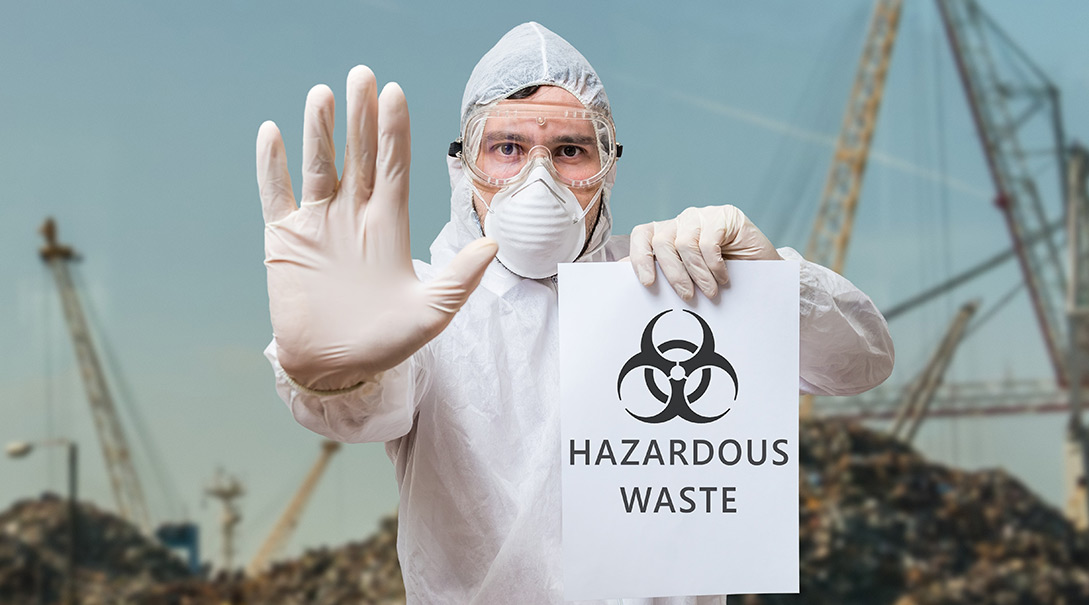Hazardous waste disposal began to grip public consciousness in the US in the mid-1900s for four key reasons:
- More waste was being produced
- Hazardous material disposal was becoming costlier
- Disposal capacity was dropping
- New disposal facilities were sparking protests.
These growing concerns eventually led to the Resource Conservation and Recovery Act (RCRA) passage of 1976. The RCRA outlined a model of environmentally sound and cost-effective approaches for managing and disposal of hazardous materials.
Due to the health and environmental risks posed by this waste, the RCRA framework was comprehensive. Based on its mandates, the EPA created a “cradle-to-grave” regulatory program that managed its full lifecycle:
- Production
- Transport
- Treatment
- Storage
- Disposal.
This article focuses on the final stage: disposal. There are a few different standard hazardous waste disposal methods. Another increasingly popular way to handle it is to recycle it. While recycling is preferable to other methods, it is not always viable. Treatment is another way to approach waste rather than simply disposing of it. Below, we explore treatment options and the three top disposal methods (along with assessing sustainability), closing out with recycling. By exploring these options, you can figure out which form of hazardous waste disposal is best for your business.
Table of Contents
Ways to Dispose of Hazardous Waste
Incineration or other treatment
There are a variety of ways to treat hazardous waste:
- Chemical treatment – e.g., neutralization, precipitation, ion exchange, reduction, or oxidation;
- Thermal treatment – e.g., incineration;
- Biological treatment – e.g., landfarming; and
- Physical treatment – e.g., solidification, flotation, sedimentation, evaporation, or filtration.
The first three categories transform waste at the molecular level, while the fourth results in waste solidification, concentration, or volume decrease.
To destroy some organic wastes, in addition to detoxifying them, you can use high-temperature incineration. Equipment used for this purpose includes:
- liquid-injection incinerators,
- multiple-hearth furnaces,
- fluidized-bed incinerators, and
- rotary kilns
Landfarming can be used to treat organic wastes from the petroleum industry or elsewhere. An area of land is designated, and the surface soil is conscientiously blended with the waste. Nutrients and waste-metabolizing microbes can be added to enhance treatment.
A common way to approach solidification is by utilizing asphalt, plastic, or concrete to encapsulate the waste. This approach creates a leach-resistant, solid material mass.
Regarding sustainability, air pollution is a concern with incineration.
#1: Underground disposal
The only way this method is compliant is when the hazardous waste is brought to mines that are either inactive or partially active (along with meeting additional geological and technical specifications). Many companies need to dispose of radioactive waste, whether from medical treatments, laboratory experiments, nuclear fuel production, or radioactive ore mining. For those cases, this method is considered a strong, cost-effective option.
According to the EPA, these hazardous material disposal facilities will vary in their sustainability. The agency is responsible for protecting people and the natural world by verifying that these units’ design, operation, and maintenance adhere to its standards.
#2: Landfill disposal
Dumpsites and landfills are the most commonly used and oldest method of hazardous waste disposal. Hazardous waste landfills are specially built and are NOT intended for liquid wastes. They are engineered and excavated so that they are within the ground rather than piling upward.
These landfills are lined with clay, HDPE, or other non-porous materials to prevent the waste from leaching into the ground. Wind dispersal controls, leak protection systems, and a double liner are additional protections so that humans and the environment come into contact with as little waste as possible.
Human health is generally not impacted by hazardous waste landfills. However, it is possible for people near the landfill to be harmed if there is a leak.
#3: Ocean dumping
For the avoidance of groundwater contamination, deep-sea depositing is sometimes used. It is necessary to treat hazardous waste before the disposal of hazardous materials, as ocean dumping has a major impact on marine life. This treatment is important to human health, too, since the waste can make its way to humans when they consume seafood. Some environmental agencies ban this practice, but it is allowed by the EPA if you have a permit and strictly follow its guidelines. (The US Army Corps of Engineers handles all dredged material permits while the EPA processes the remainder.)
Regarding sustainability, treatment is critically important. Radioactive waste, industrial waste, and sludge all cause considerable ocean pollution. Mercury and cadmium, toxic heavy metals, are within about 10 percent of dredged material.
Hazardous Waste Disposal Alternative: Recycling
A federal analysis revealed that 1.5 tons of hazardous waste were managed through recycling in 2017. Recycling is preferable to hazardous material disposal for numerous reasons. It results in economic benefits, decreases our raw material reliance nationally, conserves natural resources, prevents pollution, and cuts energy use.
Any of the following are ways that disposal of hazardous materials can be achieved:
- Reclaiming – Regeneration or processing to recover a useful product
- Reuse/use – Substituting it for another product or using it as an industrial ingredient
- Burning to recover energy – Burning for fuel
- Disposal through use – Placement of waste on the land.
Systematic & Thorough Industrial Waste Management
Are you considering your options for hazardous waste disposal? At AOTC, we design our industrial waste management services to control your costs and minimize your long-term liability. We even tailor our programs to meet your specific needs. Contact us today to discover how we can help your business. We offer environmental remediation services as well.
